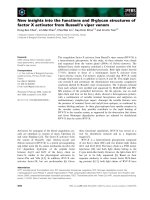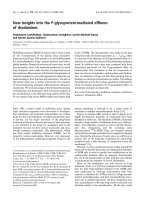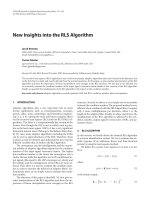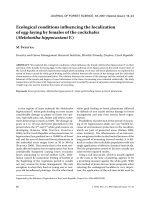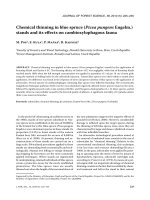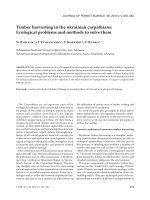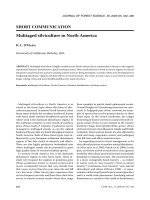Báo cáo lâm nghiệp: "New insights in the recognition of the European ash species Fraxinus excelsior L. and Fraxinus angustifolia Vahl as useful tools for forest management" pdf
Bạn đang xem bản rút gọn của tài liệu. Xem và tải ngay bản đầy đủ của tài liệu tại đây (114.12 KB, 6 trang )
Ann. For. Sci. 63 (2006) 733–738 733
c
INRA, EDP Sciences, 2006
DOI: 10.1051/forest:2006054
Original article
New insights in the recognition of the European ash species
Fraxinus excelsior L. and Fraxinus angustifolia Vahl as useful tools
for forest management
Pierre R. G
´
a
*
,JuanF.F
´
-M
´
a
,PaolaB
a
, Jean D
b
,
Christian R
a
**, Nathalie F-L
a
**
a
Écologie, Systématique, Évolution, UMR CNRS-ENGREF 8079, Bât. 360, Université Paris-Sud, 91405 Orsay Cedex, France
b
INRA, Unité Amélioration, Génétique et Physiologie Forestières, BP 20169 Ardon, 45160 Olivet, France
(Received 11 October 2005; accepted 13 January 2006)
Abstract – Common ash (Fraxinus excelsior L.) and narrow-leaved ash (F. angustifolia Vahl) are the most common ash species in Western Europe. The
former is considered to be a highly valuable timber tree and contamination of its seed lots by the latter is strongly undesirable. We studied molecular,
physiological and morphological characteristics that can help to detect the presence of F. angustifolia at the population level, either in seed and/or
seedling samples, or in adult ash leave samples from natural or managed populations. First we developed two molecular markers, which correspond to
a RAPD-SCAR marker and a nuclear microsatellite-derived marker. Results indicate that these markers are almost specific to one or the other species
for a set of populations sampled across Europe. Second, first year dormancy was studied using germination tests without stratification. F. excelsior
seeds did not germinate at all, while germinations were observed in samples of F. angustifolia and introgressed populations after 16 weeks. In addition,
F. angustifolia embryo/seed length ratios at the dispersal stage were significantly higher than those from F. excelsior populations. This study provides
straightforward and robust tools for avoiding commercial problems of impurity of seed lots and can help forest managers to certify common ash stands.
ashes / RAPD-SCAR / dormancy / discriminant markers / hybridization
Résumé – De n ouveaux outils pour la reconnaissance des frênes européens Fraxinus excelsior L. et F. angustifolia Vahl : une aide au diagnos-
tic. Le frêne commun (Fraxinus excelsior L.) et le frêne oxyphylle (F. angustifolia Vahl) sont les deux espèces de frêne les plus répandues en Europe
occidentale. Le frêne commun étant le seul à posséder une importante valeur commerciale, la contamination de lots de graines par du frêne oxyphylle
est fortement indésirable. Nous avons étudié des caractéristiques moléculaires, morphologiques et physiologiques qui pourront se révéler très utiles à la
détection de la présence de F. angus tifolia à l’échelle populationnelle, dans des lots de graines ou de semis, ainsi que dans des échantillons de feuilles
d’arbres adultes issus de populations naturelles ou exploitées. Nous avons développé deux marqueurs moléculaires, un SCAR-RAPD et un marqueur
issu d’un locus microsatellite nucléaire. Testés sur un ensemble de populations européennes, ces marqueurs se sont révélés quasi-spécifiques de l’une
ou l’autre des deux espèces. D’autre part, nous avons étudié la dormance des graines en première année par des tests de germination sans stratification.
Aucune germination n’a été observée sur un ensemble de descendances de frêne commun, alors que des germinations ont été observées sur toutes les
descendances de frêne oxyphylle après seize semaines, ainsi que sur certaines descendances issues de populations introgressées. Enfin, nous avons
montré que les embryons de F. excelsior à maturité dispersive occupent significativement moins de place dans la graine que ceux de F. angustifolia.
Cette étude permet de fournir des outils rapides et efficaces qui pourront permettre d’éviter d’éventuels problèmes commerciaux liés à la pureté de lots
de graines, et d’aider à la certification des peuplements de frêne.
frênes / SCAR-RAPD / dormance / marqueurs discriminants / hybridation
1. INTRODUCTION
The identification of closely-related species can require
multiple lines of evidence, particularly if gene flow still oc-
curs. A single type of trait, either morphological or genetic,
can be insufficient for efficient separation of groups, as it is
the case for the common ash (Fraxinus excelsior L.) and the
narrow-leaved ash (F. angustifolia Vahl.) in Western Europe.
The former is sought-after because of its tough and elastic
wood and its rapid growth. The latter, with a more Mediter-
ranean distribution [3, 15], has wood that is considered of
* Corresponding author:
** These authors have contributed equally to the project development.
lower quality under oceanic climates [19], and thus its pres-
ence is undesirable in common ash stands (see [11] for OECD
certification scheme of forest reproductive materials). Unfor-
tunately, morphological characters frequently fail to distin-
guish individuals of the two species, particularly in zones of
sympatry where interspecific hybridization has been suspected
[18, 28]. Hence, different attempts have been made to distin-
guish the two ash species with molecular tools. Recently, a
chloroplast microsatellite marker [10] was revealed to be of
limited use because of the monomorphism observed in popu-
lations where both species and putative hybrids were present
(Fernandez-Manjarrés and Gérard, unpublished results). This
feature is common in forest tree species complexes like oaks,
and can originate from a shared ancestral polymorphism or
Article published by EDP Sciences and available at or />734 P.R. Gérard et al.
from recurrent gene flow and “pollen swamping” [14]. On the
other hand, Jeandroz et al. [6] developed nine quasi species-
specific RAPD markers, which were used to detect putative
hybrid individuals in a population from a zone of sympatry.
Of the above markers, only two RAPD loci were robust in a
further study [20]. Overall such markers have poor repeatabil-
ity, and a way around these problems is the development of
Sequence Characterized Amplified Region (SCAR) markers
[4]. Therefore, currently available molecular markers are not
sufficient for ash species determination.
Even when molecular markers are efficient tools for
discriminating closely-related species (e.g. [13]), useful infor-
mation can also be obtained by examining physiological re-
sponses. Seeds of both ash species are known to exhibit dor-
mancy, which is particularly long for F. excelsior (2 to 6 years)
[23, 27, 28]. Following Nikolaeva [12], seeds of this species
are characterized by an underdeveloped embryo and morpho-
physiological dormancy. The effect of storage conditions, tem-
perature and stratification on the germination of F. excelsior
seeds (e.g. [25, 26]), F. angustifolia seeds (e.g. [17, 24]) or
both (e.g. [16, 19]) is well documented, and some studies had
pointed out differences in the strength of dormancy between
the two species [16]. Raquin et al. [19] compared the relative
efficiency of germination of F. excelsior and F. angustifolia
(with seed samples from one population of each species), ap-
plying three different treatments and suggested that germina-
tion tests can be potentially used as a first test to separate the
two species. The embryo/seed size ratio gives a first measure
of the underdevelopment of the embryo, and this character is
known to be involved in germination ability and evolution of
seed dormancy [1,2,12]. Thus, multiple tests including physio-
logical responses may be a more powerful and straightforward
approach for identifying individuals of closely-related species.
The first aim of this study was to develop repeatable molec-
ular markers: we obtained three SCARs from RAPD loci [6]
and a microsatellite-derived marker. Then we assessed the util-
ity of two of them, together with germination tests of intact un-
treated seeds and embryo/seed length ratios measurements, for
distinguishing between these two closely-related ash species at
the population level.
2. MATERIALS AND METHODS
2.1. Molecular markers
2.1.1. Marker development
For all molecular tests, DNA was extracted with a DNeasy
96
Plant Kit (Qiagen) from dried leaf material issued from 50 mg of
fresh adult tree leaves (almost one leaflet per tree). Two individ-
uals of each species on the Orsay campus, described in Morand-
Prieur et al. [10], were used to perform the primary RAPD am-
plifications. DNA was amplified following the method described
by Jeandroz et al. [6] in a MJ Research PTC-200 thermocycler,
with primers OpL03 and OpH04 (Qiagen/Operon). Three F. angus-
tifolia-specific bands were excised from a 1.5% agarose gel after
Ethidium Bromide staining: OpH04 1600 bp and OpL03 750 bp
described in Jeandroz et al. [6], and a new one, OpH04 300 bp.
Fragments were purified using a QiAquick
Gel Extraction Kit (Qi-
agen) and cloned in a pDrive Cloning Vector
, before sequencing
using M13 universal probes at Qiagen laboratories (Hilden, Ger-
many). Homology searches were performed using the BLAST algo-
rithm at (National Center for Biotech-
nology Information), with programs blastn, tblastn and tblastx. New
primers were redefined on the three sequences FaH299, FaL757 and
FaH1549 (Genbank Accession Numbers AY760060, AY760061 and
AY760062, respectively) with Primer3 software [22]. Preliminary
PCR tests were performed with 10 individuals of each species in 20 µl
solution containing 0.5 units of Q-BIOgene Taq DNA Pol, 100 µMof
each dNTP, 1.5 mM MgCl
2
,50mMKCl,20mMTris-HClpH8.3
(Q-BIOgene) and 0.5 µM of each primer. Amplifications were car-
ried out using the following program: 94
◦
Cfor3min;45cycles
(1 min denaturation at 94
◦
C, 30 s annealing, 1 min 30 s extension
at 70
◦
C); 72
◦
C for 5 min (final extension). The annealing tempera-
ture was chosen at 58
◦
C, 57
◦
C and 58
◦
C for FaH299, FaL757 and
FaH1549 respectively, depending on the T
m
of each primer (Tab. I).
Second, primers were defined on the flanking regions of the nu-
clear microsatellite locus Femsatl 19 (GenBank AN: AF020400 [7])
with Primer3 software, and the same PCR tests were carried out with
an annealing temperature of 55
◦
C.
2.1.2. Tests on population samples
Markers that showed frequency differences between the two
species were tested on mature leaves of a total of 656 individuals
from: eight F. angustifolia populations (mean number of individuals
per population: 17.9), 21 F. excelsior populations (mean number of
individuals per population: 19.1) and five populations (mean num-
ber of individuals per population: 25.4) from three areas of sympatry
between these two species (Tab. II). A bi-marker phenotype was as-
signed to each individual (0 for the absence and 1 for the presence of
the dominant marker). Four phenotypes were possible: 10, 11, 00 and
01. A Simple Correspondence Analysis (SCA) on a two-way contin-
gency table was performed on the phenotypic composition of each
population using procedure CORRESP in SAS (SAS Institute, Cary,
NC, USA).
2.2. Seed characteristics
Seeds were harvested on adult trees separated by 30 to 50 m. We
had previously carried out a study in 2004 on samples from one pop-
ulation of each species (12 trees per population) to verify the stability
of the results within a population (data not shown). These prelimi-
nary data conducted us to evaluate germination and embryo size pat-
terns at a larger scale: three provenances of each species were chosen
for the experiment in 2005, from which seeds of sufficient quantity
and quality were available (F. angustifolia: three populations from La
Mole-Cogolin, Cuxac d’Aude and Cazouls-lès-Béziers from South-
ern France, F. excelsior: three populations from Orsay campus natu-
ral vegetation, Dourdan forest and Alençon seed orchard from North-
Western France). Three mother trees were chosen in each population.
In addition, seeds were harvested on three mother trees in two pop-
ulations from zones of sympatry in France (St-Dyé-sur Loire, Loire
valley and Tavaux, Saône valley) to evaluate germination ability and
embryo/seed length ratio variation in comparison with the popula-
tions of the two species.
European ash species recognition 735
Table I. Sequence and characteristics of primers used.
Name
2
and sequence (5’→3’) Position
1
Size T
m
GC
(mers) (
◦
C) (%)
FaH299F GGAAGTCGCCCTTAGACTTTG 1-21 21 59.8 52.4
FaH299R GCCAAATGGCCTTACACAAC 273-292 20 57.3 50.0
FaL757F CAGCTTGGTGAGCGATCC 5-22 18 58.2 61.1
FaL757R CCAGCAGCTTCACAAGGTTA 738-757 20 57.3 50.0
FaH1549F GAAGTCGCCGCTATCAAGTAA 2-22 21 57.9 47.6
FaH1549R GGAAGTCGCCCTCTTTTGC 1531-1549 19 58.8 57.9
F19LgF TTGATATAGGAATGCCAGAGC 3-23 21 57.0 42.9
F19LgR CAGATACTCGCGTATGATGGTC 436-457 22 59.6 50.0
1
Position in the SCAR-RAPD sequence.
2
F and R represent forward and reverse primers, respectively.
For germination tests, 160 seeds per mother tree were sown di-
rectly without any prior treatment in 40 × 40 cm boxes, containing a
1:1 mixture of leaf mould (Floradur
, Floragard) and chalk-less sand.
Boxes were placed in the greenhouse under natural light conditions
(Mean temperature: 18.5
◦
C during winter 2005). Germinated seeds
were counted every week during 16 weeks.
For embryo size measurements, 16 seeds per mother tree were re-
hydrated and sterilized as described in Raquin et al. [19], and embryo
length was measured under a Wild M5 stereomicroscope at magnifi-
cation 6×. After verifying that the variable “embryo/seed length ra-
tio” (E:S ratio) did not deviate from a normal distribution within sam-
ples of each species we compared E:S ratios between the two species
using procedure NESTED in SAS, with mother tree nested within
population nested within species (the samples from sympatry were
not included in the analysis of variance). When analysing balanced
data, this procedure allows determination of the amount of total vari-
ation explained by each level (factor) on the observed data [29].
3. RESULTS
3.1. Molecular markers
No homology with any sequence from nucleotide or trans-
lated databases was found along the three SCAR sequences.
Of the three SCAR markers (Tab. I), only FaL757 was used
further because FaH299 and FaH1549 were both present in all
individuals tested in preliminary tests (data not shown).
The two markers FaL757 and that corresponding to the en-
tire nuclear microsatellite Femsatl 19 locus (amplified with the
primers described in Tab. I, named F19Lg) were complemen-
tary, i.e. they were not present at high frequency in the same
species (Tab. II). Among all samples, FaL757 was present at
high frequency in F. angustifolia populations (70.6% of pres-
ence in the total sample), whereas it was almost absent from
the F. excelsior populations (10.6% frequency in the total sam-
ple). Its frequency was 20% in the populations from zones of
sympatry. On the other hand, F19Lg was present at very high
frequency in F. excelsior populations (95%), but was rare in
the F. angustifolia populations (15%). In sympatric popula-
tions, this marker had a frequency of 55% (Tab. II). The SCA
(Tab III) allowed populations to be assigned to one of the two
species: the proportion of the extreme phenotypes (10 and 01)
determined the first axis (which explained 73.65% of the ob-
served variation), while the second axis represented the pro-
portion of intermediate phenotypes (00 and 11) and explained
only 16.32% of the observed variation (Fig 1). The populations
from the zone of sympatry were distributed between the two
groups, and the population of St-Dyé (S5) was a good example
of a mixed population.
3.2. Seed characteristics
The percentages of germination obtained for populations
of the two species and from the zone of sympatry (Tab. II)
reinforced the results obtained by Raquin et al. [19] with de-
pericarped, rehydrated and sterilized seeds. Germination was
observed only for seeds of F. angustifolia (for all progeny ar-
rays) and St-Dyé and Tavaux seed lots. Moreover, the mean
germination rate was two-fold higher for F. angustifolia seeds
than for seeds from zones of sympatry.
The E:S ratio did not deviate significantly from normal-
ity for either species (Cramer-von Mises test: W-sq = 0.06,
P > 0.25 for F. excelsior,W-sq= 0.09, P = 0.15 for F. an-
gustifolia). Values of E:S ratio were significantly higher in
F. angustifolia populations (Tab. II): the level “species” ex-
plained 77% of the total observed variation (F
1,4
= 43.42,
P = 0.0027), the level “population” explained 1% of this vari-
ation (F
4,12
= 1.30, P = 0.33, n. s.) and the level “mother tree”
explained 12% (F
12,270
= 19.99, P < 0.0001).
These results were in agreement with the preliminary data
analysis on seeds of 2004 that were structured in only two lev-
els, with the population and species levels being confounded
(results not shown).
4. DISCUSSION
The two molecular markers we developed can be used un-
der any laboratory conditions, contrary to the RAPD mark-
ers developed earlier [6, 10]. Not surprisingly FaL757 and
736 P.R. Gérard et al.
Table II. Description of the study populations (sample size, origin, latitude, longitude). Absolute frequencies of bi-marker phenotypes are
given, as well as mean percentage of germinations in population samples and mean E:S ratios.
Population N
a
Country Code Lat. Long.
Bi-marker phenotypes
b
%
E:S ratio
d
10 00 11 01 germ.
c
F. excelsior
Farchau 17 Germany E1 53
◦
41’ 3
◦
47’01016
Hoge Bos 15 Belgium E2 50
◦
50’ 2
◦
57’02112
Abetone 20 Italy E3 44
◦
11’ 10
◦
38’01019
Cadore 14 Italy E4 46
◦
30’ 12
◦
28’01013
Monti Lessini 20 Italy E5 45
◦
40’ 11
◦
13’02018
Valle Pesio 20 Italy E6 44
◦
15’ 7
◦
39’02018
Kasiadorys 20 Lituany E7 54
◦
51’ 24
◦
25’02018
Zeimelio 20 Lituany E8 56
◦
16’ 24
◦
00’03116
Rabstejn 18 Czech R. E9 50
◦
50’ 14
◦
20’00018
Donadea 16 Ireland E10 53
◦
20’ 6
◦
45’00016
Enniskillen 20 Ireland E11 54
◦
14’ 7
◦
28’00515
Currachase 17 Ireland E12 52
◦
36’ 8
◦
53’01610
Wytham 15 UK E13 51
◦
47’ 1
◦
20’00411
Settrington 12 UK E14 54
◦
01’ 0
◦
69’ 1 0 3 8
La Romagne 20 France E15 49
◦
40’ 4
◦
19’00020
Athis 20 France E16 49
◦
01’ 4
◦
07’02315
St-Gatien 19 France E17 49
◦
21’ 0
◦
11’01315
St-Paul-de-S. 21 France E18 45
◦
08’ 2
◦
31’00318
Dourdan 20 France E19 48
◦
31’ 2
◦
00’00020 0(0)0.50(0.07)
Orsay 8 France E20 48
◦
42’ 2
◦
11’ 0 0 1 7 0 (0) 0.51 (0.10)
Alençon 24 France E21 48
◦
29’ 0
◦
07’00915 0(0)0.46(0.07)
Overall 376 1 18 39 318 0 (0) 0.49 (0.08)
F. angustifolia
Alter do Chao 20 Portugal A1 39
◦
12’ 7
◦
40’ 14 4 1 1
Boujan-sur-L. 23 France A2 43
◦
23’ 3
◦
14’ 14 4 5 0
Grabels 18 France A3 43
◦
39’ 3
◦
47’ 7 7 2 2
Mas-Larrieu 24 France A4 42
◦
36’ 3
◦
02’ 17 4 3 0
Cogolin 10 France A5 43
◦
12’ 6
◦
28’ 6 3 1 0
La Mole 10 France A6 43
◦
25’ 6
◦
53’ 5 1 3 1 4 (3) 0.69 (0.09)
Cuxac d’Aude 24 France A7 43
◦
16’ 2
◦
59’ 10 11 2 1 18 (14) 0.71 (0.08)
Cazouls-lès-B. 24 France A8 43
◦
25’ 3
◦
07’ 17 6 1 0 20 (11) 0.80 (0.09)
Overall 153 90 40 18 5 14 (12) 0.73 (0.10)
Zone of sympatry
Hohenau 9 Austria S1 48
◦
36’ 16
◦
55’ 0 3 0 6
Rigny 30 France S2 47
◦
28’ 5
◦
38’ 1 15 0 14
Tavaux 20 France S3 47
◦
02’ 5
◦
24’15212 2(2)0.59(0.08)
St-Pryvé 20 France S4 47
◦
53’ 1
◦
52’03314
St-Dyé-sur-L. 48 France S5 47
◦
39’ 1
◦
29’ 14 15 5 14 12 (10) 0.70 (0.11)
Overall 127 16 41 10 60 7 (8) 0.65 (0.11)
a
Sample size for molecular marker analysis.
b
The first number represent the phenotype presence (1) / absence (0) of FaL757, and the second number that of F19Lg.
c
Mean percentage of germinated seeds (standard deviation).
d
Mean embryo/seed length ratio (standard deviation).
F19Lg are not strictly species-specific, since these closely-
related species sometimes hybridize and thus still exchange
genes [5, 8]. Nevertheless, they allow discrimination between
the two species at the population level. In zones of sympatry,
it is preferable to use them concomitantly with the study of
seed characters. For example, the Tavaux population (Saône
valley) exhibits a large proportion of F19Lg, indicating F. ex -
celsior-like provenance, but some germinations were observed
and E:S ratios were intermediate, indicating the presence of F.
angustifolia-like genotypes. Indeed, this population has been
shown to be mainly composed of morphologically F. excel-
sior-like individuals, but a small amount of introgression by
F. angustifolia gene pool was detected (Fernandez-Manjarrés
et al., submitted). On the other hand, the St-Dyé stand (Loire
valley) can be robustly characterised as an admixed popula-
tion as it exhibits both molecular markers in similar propor-
tions, and intermediate germination rates and high E:S ratios.
In an intensive local scale study, we demonstrated that this
hybrid zone population was composed in a major part of F.
angustifolia gene pool, and that parental species and different
European ash species recognition 737
Figure 1. Simple Correspondence Analysis (SCA) on bi-marker phenotypes. Circles represent F. excelsior populations, triangles represent
F. angustifolia populations and stars represent populations from zones of sympatry (codes are listed in Tab. II). Crosses are plotted at the
coordinates of the four phenotypes in the first two dimension of the SCA (the first number in the brackets represent the phenotype presence
(1)/absence (0) of FaL757, and the second number that of F19Lg). The percentages of the total inertia provided by the first two dimensions are
shown in brackets on each axis.
Table III. Inertia and chi-square decomposition of the Simple Corre-
spondence Analysis (SCA).
Singular value Principal inertia Chi-square % Cumulative %
0.79839 0.63742 418.150 73.65 73.65
0.37581 0.14123 92.648 16.32 89.97
0.29464 0.08681 56.948 10.03 100.00
Total 0.86547 567.746 100.00 d.f.
a
= 99
a
Degrees of freedom.
types of hybrids were present (Gérard et al., submitted). By
extension, other combinations of marker frequencies and seed
characteristics could signal other types of admixed or hybrid
populations, since hybrid segregation usually produces a mo-
saic of morphological and molecular markers that can vary
among hybrid zones, particularly relative to varying selection
regimes [21].
The germination test is a simple way to detect the pres-
ence of narrow-leaved ash seeds, but the sample size needs
to be sufficient and the results may depend on the damaging
degree of the seed lot. We chose to conduct the test on in-
tact samaras (seeds within the fruit), first because we wanted
to know the ability of both species to germinate without any
treatment at all, and second to be able to provide a straight-
forward means for managers to rapidly detect the presence of
F. angustifolia seeds. But it is sometimes difficult to detect in-
fected seeds without removing the pericarp [17]. Only empty
samaras were removed from the samples. We also acknowl-
edge that the number of sampled populations for the two seed
experiments is not very large, although it covers a large geo-
graphic area. Nevertheless, germinations were observed in all
F. angustifolia seed lots and no germination whatsoever was
observed for any F. excelsior seed lots: it seems that stratifica-
tion is absolutely necessary to remove first-year dormancy in
F. excelsior seeds. These same germination patterns were also
found across a broader range of F. angustifolia and F. excelsior
provenances and similarly E:S ratios differed between the two
species (Gérard and Raquin, unpublished results).
This investigation on ash seeds showed particular develop-
mental characters of the species. The embryo made up a larger
proportion of the seed in F. angustifolia and this species pro-
duces more vigorous seedlings during the first years of growth
(Dufour, unpublished results). This could represent a better
ability for colonizing newly open forest gaps or open habitats,
and thus explain the replacement of common ash by narrow-
leaved ash in some regions [9]. Embryo size also affects ger-
mination and dormancy. Morphological dormancy is due to
underdevelopment of the embryo at the seed dispersal stage
and is considered ancestral in seed plants [1, 2]. Common ash
seeds with their small embryos seem to exhibit morphophys-
iological dormancy [12] while narrow-leaved ash seeds ap-
pear to retain only physiological dormancy [16]: the embryo
usually does not seem to be underdeveloped. The evolution
738 P.R. Gérard et al.
towards large embryos in the seeds of this latter species may
have been possible by changes in developmental timing (i.e.
heterochrony [2]) possibly selected in F. angustifolia as an
adaptation to Mediterranean ecological and climatic condi-
tions. Indeed in a wide-scale study of these two species (some
populations were the same as in the present study) and their
hybrids, we showed that their range distributions are linked
to environmental features such as altitude, number of frost
days and annual mean temperature (Fernandez-Manjarrés et
al., submitted).
In conclusion, we developed a set of robust and powerful
tools for rapidly detecting the presence of F. angustifolia in
the field or in seed lots, which could be easily applied by forest
managers. The present set of markers allows us to distinguish
the two species adequately and this discrimination improves
with increasing sample sizes, which was not the case for earlier
studies. Moreover, the present study points out possibly differ-
ent ecological strategies of the two species that can be linked
with their colonizing abilities (see [9] for F. excelsior). This
can be useful for studies of hybridization in zones of sympa-
try and/or of putative replacement of common ash by narrow-
leaved ash, for example in the context of global change.
Acknowledgements: We thank Céline Devaux, Marie-
Elise Morand-Prieur, Jacqui Shykoff, Carol Baskin, Marc Masimbert
and two anonymous reviewers for helpful comments on the
manuscript and discussions, Francina Langa and Jérôme Artus (Pas-
teur Institute) for the use of their thermocycler, and Lionel Saunois
for technical assistance. This work is a part of the Ph.D. thesis of
PRG financed by the French MENRT and the French Institute for
Biodiversity (IFB). Financial support was provided by DGFAR
(Ministry of Agriculture), IFB and European Commission (RAP
Project QLK5-2001-00631) grants to NFL.
REFERENCES
[1] Baskin C.C., Baskin J.M., Seeds: ecology, biogeography, and evo-
lution of dormancy and germination, Academic Press, San Diego,
1998.
[2] Forbis T.A., Floyd S.K., de Queiroz A., The evolution of embryo
size in angiosperms and other seed plants: implications for the evo-
lution of seed dormancy, Evolution 56 (2002) 2112–2125.
[3] Franc A., Ruchaud F., Le frêne commun, in: Autécologie des feuil-
lus précieux : frêne commun, merisier, érable sycomore, erable
plane, CEMAGREF éd., Riom, France, 1996, pp. 15–68.
[4] Hernandez P., Martin A., Dorado G., Development of SCARs by
direct sequencing of RAPD products: a practical tool for the in-
trogression and marker-assisted selection of wheat, Mol. Breed. 5
(1999) 245–253.
[5] Hey J., Waples R.S., Arnold M.L., Butlin R.K., Harrison R.G.,
Understanding and confronting species uncertainty in biology and
conservation, Trends Ecol. Evol. 18 (2003) 597–603.
[6] Jeandroz S., Frascaria-Lacoste N., Bousquet J., Molecular recog-
nition of the closely related Fraxinus excelsior and F. oxyphylla
(Oleaceae) by RAPD markers, For. Genet. 3 (1996) 237–242.
[7] Lefort F., Brachet S., Frascaria-Lacoste N., Edwards K.J., Douglas
G.C., Identification and characterization of microsatellite loci in ash
(Fraxinus excelsior L.) and their conservation in the olive family
(Oleaceae), Mol. Ecol. 8 (1999) 1075–1092.
[8] Mallet J., Hybridization as an invasion of the genome, Trends Ecol.
Evol. 20 (2005) 229–237.
[9] Marigo G., Peltier J P., Girel J., Pautou G., Success in the demo-
graphic expansion of Fr axinus excelsior L., Trees 15 (2000) 1–13.
[10] Morand-Prieur M E., Vedel F., Raquin C., Brachet S., Sihachakr
D., Frascaria-Lacoste N., Maternal inheritance of a chloroplast mi-
crosatellite marker in controlled hybrids between F raxinus excelsior
and F raxinus angustifolia, Mol. Ecol. 11 (2002) 613–617.
[11] Nanson A., The new OECD scheme for the certification of forest
reproductive materials, Silvae Genet. 50 (2001) 181–187.
[12] Nikolaeva M.G., On criteria to use in studies of seed evolution, Seed
Sci. Res. 14 (2004) 315–320.
[13] Perron M., Gordon A.G., Bousquet J., Species-specific RAPD fin-
gerprints for the closely related Picea mariana and P. rubens, Theor.
Appl. Genet. 91 (1995) 142–149.
[14] Petit R.J., Bodénès C., Ducousso A., Roussel G., Kremer A.,
Hybridization as a mechanism of invasion in oaks, New Phytol. 161
(2004) 151–164.
[15] Picard J F., À propos du frêne oxyphylle, Fraxinus angustifolia
Vahl., Forêt-Entreprise 83 (1983) 2–4.
[16] Piotto B., Effects of temperature on germination of stratified seeds
of three ash species, Seed Sci. Technol. 22 (1994) 519–529.
[17] Preece J.E., Bates S.A., Van Sambeek J.W., Germination of cut
seeds and seedling growth of ash (Fraxinus spp.) in vitro, Can. J.
For. Res. 25 (1995) 1368–1374.
[18] Rameau J.C., Mansion D., Dumé G., Flore forestière française,
guide écologique illustré. Tome 1. Plaines et collines, Institut pour
le Développement Forestier, Paris, 1989.
[19] Raquin C., Jung-Muller B., Dufour J., Frascaria-Lacoste N., Rapid
seedling obtaining from European ash species F r axinus e xcelsior
(L.) and Fraxinus angustifolia (Vahl), Ann. For. Sci. 59 (2002) 219–
224.
[20] Raquin C., Brachet S., Jeandroz S., Vedel F., Frascaria-Lacoste N.,
Combined analyses of microsatellite and RAPD markers demon-
strate possible hybridisation between Fr axinus excelsior L. and
Frax inus angustifolia Vahl, For. Genet. 9 (2002) 103–111.
[21] Rieseberg L.H., Ellstrand N.C., What can molecular and morpho-
logical markers tell us about plant hybridization? Crit. Rev. Plant
Sci. 12 (1993) 213–241.
[22] Rozen S., Skaletsky H.J., Primer3 on the WWW for general users
and for biologist programmers, in: Krawetz S., Misener S. (Eds.),
Bioinformatics Methods and Protocols: Methods in Molecular
Biology, Humana Press, Totowa, NJ, 2000, pp. 365–386.
[23] Steinbauer G.P., Dormancy and germination of Fraxinus seeds,
Plant Physiol. 12 (1937) 813–824.
[24] Tilki F., Çiçek E., Effects of stratification, temperature and storage
on germination in three provenances of Fraxinus angustifolia subsp.
oxycarpa seeds, Turk. J. Agric. For. 29 (2005) 323–330.
[25] Tylkowski T., Mediumless stratification and dry storage of after-
ripened seeds of Fraxinus excelsior L., Arbor. Kornic. 35 (1990)
143–152.
[26] Villiers T.A., Wareing P.F., Dormancy in fruits of Fraxinus excelsior
L., J. Exp. Bot. 15 (1964) 359–367.
[27] Wagner J., Kafka I., Effects of medium composition on in vitro ger-
mination of embryos of Fr axinus excelsior at different stages of de-
velopment, J. Plant Physiol. 146 (1995) 566–568.
[28] Wardle P., Biological flora of the British Isles. Fraxinus excelsior
L., J. Ecol. 49 (1961) 739–751.
[29] Zar J.H., Biostatistical analysis, 2nd ed., Prentice-Hall Inc.,
London, UK, 1984.
